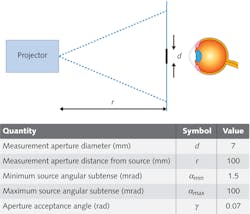PICOPROJECTORS: Eye-safety analysis sheds light on scanned-beam picoprojectors
Picoprojectors, with typical output values below 50 lumens (50 lm), are based on a number of different architectures: Scanning systems use one or more rapidly scanning silicon micromirrors to deflect red/green/blue (RGB) laser light and "paint" an image pixel by pixel; digital-light-processing (DLP) or microelectromechanical systems (MEMS)-based projectors use projection optics to create an image all at once as RGB light reflects off the individual mirror elements; or optics are used to magnify and project the image from a liquid-crystal-on-silicon (LCoS) microdisplay. The latter two architectures can use either laser or LED sources, but scanned-beam systems depend upon laser illumination. While scanned-beam systems have the potential for continued miniaturization and high optical efficiency, they can suffer from laser speckle, limited brightness, and high cost.
In an effort to better understand the "brightness roadmap" of laser-based, scanned-beam picoprojection systems, Edward Buckley (based in Jackson, WY) used International Electrotechnical Commission (IEC; www.iec.ch) IEC 60825-1 laser-safety standards to analyze and compare this type of picoprojection technology.1 His findings suggest that the maximum luminous-flux output of laser-based, scanned-beam picoprojectors could be limited by the requirement of meeting the relevant laser-safety standards.
Methodology
IEC 60825-1 states that the acceptable exposure limit (AEL) for the human eye to meet visible-wavelength laser-safety classifications is found by measuring the incident radiation from a source through a d = 7 mm aperture a distance r = 100 mm to the aperture (see figure). Since the laser-safety classifications are defined as not exceeding a predefined radiometric optical-power level, it is possible to find a photometric measure at a given white balance—the maximum luminous flux or Lmax—that the projector should not exceed.
Using the standard AEL methodology and making assumptions about the scanned-beam projection system under consideration, Buckley was able to find a maximum radiometric output power value that satisfied the laser-safety regulations. Then, by assuming a white point with color temperature of 6500 K for laser sources with RGB wavelengths of 445, 523, and 642 nm, Buckley was able to determine the photometric quantity Lmax that gave the correct D65 color balance in the CIE color space.
Findings
Assuming some example system parameters for a WVGA resolution (850 × 480 pixels), 60 Hz frame-rate single-mirror-scanned picoprojection system using single-pulse and pulse-train parameters, Buckley found a maximum 11 lm output requirement to meet Class 2 laser-safety standards. To meet Class 1 laser-safety standards, maximum output is limited to only 1 lm. Although there are certain design approaches that could increase these possible output values (using a 638 nm red laser could increase the Class 2 limit to 12 lm, for example), the analysis indicates that these laser-safety limitations in beam-scanning picoprojection systems could hurt future commercial viability, especially considering that DLP-based systems with eye-safe LED sources can already achieve 15 lm outputs and Class 1-compliant LCoS microdisplay-based picoprojectors are available with 15 lm and 20 lm output values.
"There appears to be much confusion regarding the brightness roadmap of laser-based projection systems, and scanned-beam projectors in particular," says Buckley. "I very much hope that this analysis, and a forthcoming publication on eye-safety aspects of LCoS-based laser projectors, can help inform some reasoned debate on the capabilities and safety classification of laser-based projection systems."
REFERENCE
1. E. Buckley, J. Soc. for Information Display (SID), 18, 11, 944-951 (November 2011).

Gail Overton | Senior Editor (2004-2020)
Gail has more than 30 years of engineering, marketing, product management, and editorial experience in the photonics and optical communications industry. Before joining the staff at Laser Focus World in 2004, she held many product management and product marketing roles in the fiber-optics industry, most notably at Hughes (El Segundo, CA), GTE Labs (Waltham, MA), Corning (Corning, NY), Photon Kinetics (Beaverton, OR), and Newport Corporation (Irvine, CA). During her marketing career, Gail published articles in WDM Solutions and Sensors magazine and traveled internationally to conduct product and sales training. Gail received her BS degree in physics, with an emphasis in optics, from San Diego State University in San Diego, CA in May 1986.
